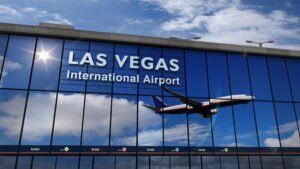
People attempting to get through Harry Reid Airport security with a firearm face arrest and serious federal charges, even if they genuinely forgot they were carrying a gun. All gun owners should be familiar with the following state and federal firearm rules for airports:
1. Open carry at airports
In general, people may openly carry firearms in airports outside of the secured areas. In other words, people may not carry their guns through security.
TSA will detain and arrest people allegedly trying to get through security with a firearm. Suspects then face prosecution under 49 U.S. Code § 46505, carrying a felony penalty of:
- a fine, and/or
- up to 10 years in Federal Prison
It is also against the law to take through security the following:
- knives,
- ammunition,
- replica firearms, and
- firearm parts (such as magazines, clips, bolts and firing pins)
Note that people are permitted to carry rifle scopes in carry-on baggage.
2. Concealed carry at airports
The concealed carry of guns is prohibited at all public Nevada airports anywhere in the building. It makes no difference if the carrier has a current and valid Nevada CCW permit.
Carrying a concealed firearm in a public Nevada airport is a misdemeanor in Nevada. The sentence is:
- up to six (6) months in jail, and/or
- up to $1,000 in fines
Note that people who attempt to conceal carry through security face more serious federal charges discussed in section 1 (above).
3. Transporting firearms on flights
Travelers are generally allowed to check their firearms — as well as ammunition and firearm parts — as long as:
- the traveler declares the firearms and ammunition to the airline before checking the baggage,
- the firearms are unloaded (meaning there is no live round of ammunition in the chamber or cylinder or magazine in the gun), and
- the firearms are in a locked hard-sided container that completely secures the weapons from others accessing them
Ammunition that is considered “small arms” — which includes shotgun shells and ammo no bigger than .75 caliber — can be transported in the same hard-sided case as a gun.
Note that people have to check their knives unless they are plastic or round bladed butter knives.
Learn more about Nevada firearm laws.
Legal References
- 49 CFR § 1540.111 Carriage of weapons, explosives, and incendiaries by individuals. (a) On an individual’s person or accessible property – prohibitions. Except as provided in paragraph (b) of this section, an individual may not have a weapon, explosive, or incendiary, on or about the individual’s person or accessible property – (1) When performance has begun of the inspection of the individual’s person or accessible property before entering a sterile area, or before boarding an aircraft for which screening is conducted under this subchapter; (2) When the individual is entering or in a sterile area; or (3) When the individual is attempting to board or onboard an aircraft for which screening is conducted under §§ 1544.201, 1546.201, or 1562.23 of this chapter. (b) On an individual’s person or accessible property – permitted carriage of a weapon. Paragraph (a) of this section does not apply as to carriage of firearms and other weapons if the individual is one of the following: (1) Law enforcement personnel required to carry a firearm or other weapons while in the performance of law enforcement duty at the airport. (2) An individual authorized to carry a weapon in accordance with §§ 1544.219, 1544.221, 1544.223, 1546.211, or subpart B of part 1562 of this chapter. (3) An individual authorized to carry a weapon in a sterile area under a security program. (c) In checked baggage. A passenger may not transport or offer for transport in checked baggage or in baggage carried in an inaccessible cargo hold under § 1562.23 of this chapter: (1) Any loaded firearm(s). (2) Any unloaded firearm(s) unless – (i) The passenger declares to the aircraft operator, either orally or in writing, before checking the baggage, that the passenger has a firearm in his or her bag and that it is unloaded; (ii) The firearm is unloaded; (iii) The firearm is carried in a hard-sided container; and (iv) The container in which it is carried is locked, and only the passenger retains the key or combination. (3) Any unauthorized explosive or incendiary. (d) Ammunition. This section does not prohibit the carriage of ammunition in checked baggage or in the same container as a firearm. Title 49 CFR part 175 provides additional requirements governing carriage of ammunition on aircraft.
- 49 U.S. Code § 46505 – Carrying a weapon or explosive on an aircraft (a) Definition.—
In this section, “loaded firearm” means a starter gun or a weapon designed or converted to expel a projectile through an explosive, that has a cartridge, a detonator, or powder in the chamber, magazine, cylinder, or clip. (b) General Criminal Penalty.—An individual shall be fined under title 18, imprisoned for not more than 10 years, or both, if the individual—
(1) when on, or attempting to get on, an aircraft in, or intended for operation in, air transportation or intrastate air transportation, has on or about the individual or the property of the individual a concealed dangerous weapon that is or would be accessible to the individual in flight;
(2) has placed, attempted to place, or attempted to have placed a loaded firearm on that aircraft in property not accessible to passengers in flight; or
(3) has on or about the individual, or has placed, attempted to place, or attempted to have placed on that aircraft, an explosive or incendiary device. (c) Criminal Penalty Involving Disregard for Human Life.—
An individual who willfully and without regard for the safety of human life, or with reckless disregard for the safety of human life, violates subsection (b) of this section, shall be fined under title 18, imprisoned for not more than 20 years, or both, and, if death results to any person, shall be imprisoned for any term of years or for life. (d) Nonapplication.—Subsection (b)(1) of this section does not apply to—
(1) a law enforcement officer of a State or political subdivision of a State, or an officer or employee of the United States Government, authorized to carry arms in an official capacity;
(2) another individual the Administrator of the Federal Aviation Administration or the Under Secretary of Transportation for Security by regulation authorizes to carry a dangerous weapon in air transportation or intrastate air transportation; or
(3) an individual transporting a weapon (except a loaded firearm) in baggage not accessible to a passenger in flight if the air carrier was informed of the presence of the weapon. (e) Conspiracy.—
If two or more persons conspire to violate subsection (b) or (c), and one or more of such persons do any act to effect the object of the conspiracy, each of the parties to such conspiracy shall be punished as provided in such subsection. - NRS 202.3673 Permittee authorized to carry concealed firearm while on premises of public building; exceptions; penalty. 1. Except as otherwise provided in subsections 2 and 3, a permittee may carry a concealed firearm while the permittee is on the premises of any public building. 2. A permittee shall not carry a concealed firearm while the permittee is on the premises of a public building that is located on the property of a public airport. 3. A permittee shall not carry a concealed firearm while the permittee is on the premises of: (a) A public building that is located on the property of a public school or a child care facility or the property of the Nevada System of Higher Education, unless the permittee has obtained written permission to carry a concealed firearm while he or she is on the premises of the public building pursuant to subparagraph (3) of paragraph (a) of subsection 3 of NRS 202.265. (b) A public building that has a metal detector at each public entrance or a sign posted at each public entrance indicating that no firearms are allowed in the building, unless the permittee is not prohibited from carrying a concealed firearm while he or she is on the premises of the public building pursuant to subsection 4. 4. The provisions of paragraph (b) of subsection 3 do not prohibit: (a) A permittee who is a judge from carrying a concealed firearm in the courthouse or courtroom in which the judge presides or from authorizing a permittee to carry a concealed firearm while in the courtroom of the judge and while traveling to and from the courtroom of the judge. (b) A permittee who is a prosecuting attorney of an agency or political subdivision of the United States or of this State from carrying a concealed firearm while he or she is on the premises of a public building. (c) A permittee who is employed in the public building from carrying a concealed firearm while he or she is on the premises of the public building. (d) A permittee from carrying a concealed firearm while he or she is on the premises of the public building if the permittee has received written permission from the person in control of the public building to carry a concealed firearm while the permittee is on the premises of the public building. 5. A person who violates subsection 2 or 3 is guilty of a misdemeanor. 6. As used in this section: (a) “Child care facility” has the meaning ascribed to it in paragraph (a) of subsection 5 of NRS 202.265. (b) “Public building” means any building or office space occupied by: (1) Any component of the Nevada System of Higher Education and used for any purpose related to the System; or (2) The Federal Government, the State of Nevada or any county, city, school district or other political subdivision of the State of Nevada and used for any public purpose. -> If only part of the building is occupied by an entity described in this subsection, the term means only that portion of the building which is so occupied.
- TSA Knife laws and TSA gun laws.

